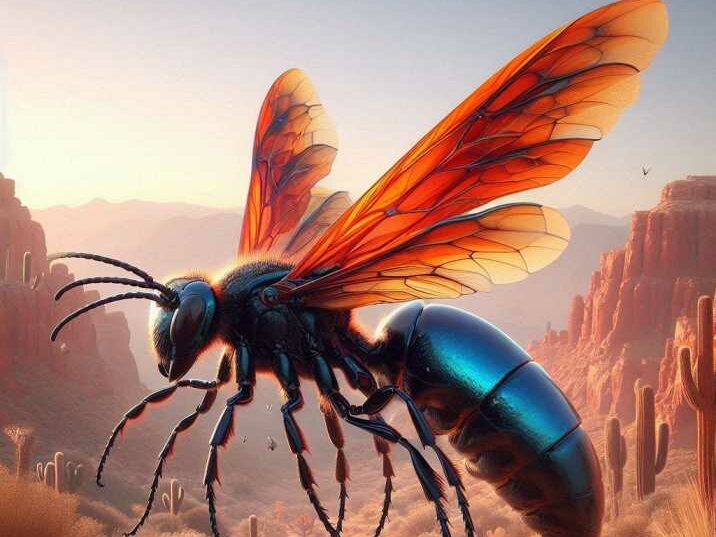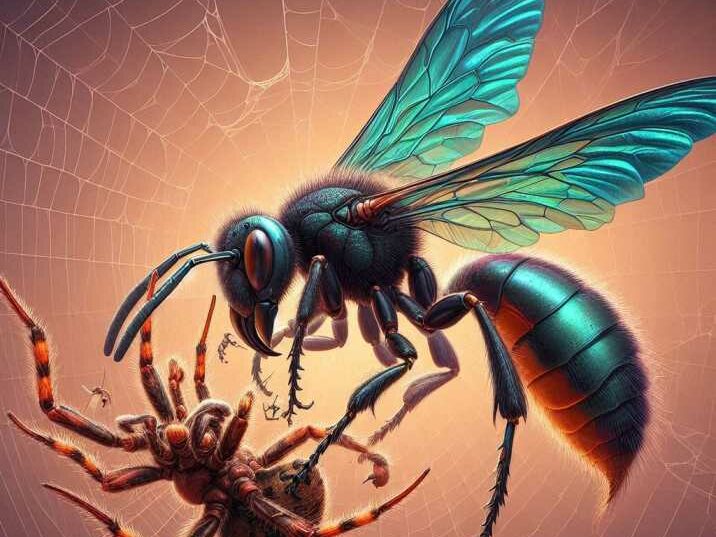Introduction
Table of Contents
Have you ever heard of the Tarantula Hawk? It sounds like a scary creature, but is it really dangerous? In this article, we’ll explore what tarantula hawks are, where they live, and whether are tarantula hawks dangerous to humans. We’ll also look at some interesting facts about these unique insects.

Table of Contents
- What is a Tarantula Hawk?
- Habitat of Tarantula Hawks
- The Life Cycle of a Tarantula Hawk
- Are Tarantula Hawks Dangerous to Humans?
- Interesting Facts About Tarantula Hawks
- How to Avoid Tarantula Hawks
- Frequently Asked Questions (FAQs)
- Conclusion
What is a Tarantula Hawk?
Tarantula Hawks are a type of wasp known for their striking appearance and interesting behavior. Here, we’ll delve into the details about these fascinating creatures.
Appearance
Tarantula hawks are large wasps with shiny blue-black bodies and bright orange wings. They can be quite big, sometimes reaching up to 2 inches in length. Their long legs are equipped with hooked claws that help them capture and hold onto their prey.
Behavior
Tarantula hawks are known for their unique hunting technique. They hunt tarantulas, hence their name. The female tarantula hawk stings and paralyzes a tarantula, then lays an egg on its body. When the egg hatches, the larva feeds on the still-living tarantula.
Habitat of Tarantula Hawks
Tarantula Hawks can be found in various parts of the world, but they are most commonly seen in warm climates. Let’s explore where these wasps live and what kind of environment they prefer.
Geographic Distribution
Tarantula hawks are mainly found in the Southwestern United States, Central America, and South America. They thrive in deserts and other warm, dry environments.
Preferred Environment
These wasps prefer habitats where tarantulas are abundant. Deserts, scrublands, and other arid regions with plenty of tarantula burrows are ideal for tarantula hawks.
The Life Cycle of a Tarantula Hawk
Understanding the life cycle of a tarantula hawk can help us appreciate these creatures even more. Let’s take a closer look at their stages of life.
Egg
The female tarantula hawk lays a single egg on a paralyzed tarantula. The tarantula is still alive but unable to move, providing a fresh food source for the hatching larva.
Larva
Once the egg hatches, the larva begins to feed on the tarantula. It consumes the non-essential organs first, keeping the tarantula alive as long as possible.
Pupa
After the larva has had its fill, it enters the pupal stage. During this time, it develops into an adult wasp inside a cocoon.

Adult
The adult tarantula hawk emerges from the cocoon and starts the cycle anew. Adult tarantula hawks primarily feed on nectar from flowers.
Are Tarantula Hawks Dangerous to Humans?
Many people wonder if tarantula hawks pose a threat to humans. Let’s explore this question in detail.
Sting and Pain
Tarantula hawks have a very powerful sting, which is considered one of the most painful insect stings in the world. However, their sting is not dangerous to humans unless you are allergic. The pain from a tarantula hawk sting is intense but short-lived, usually lasting only a few minutes.
Allergic Reactions
As with any insect sting, some people might be allergic. If stung by a tarantula hawk, it’s important to monitor for any signs of an allergic reaction, such as difficulty breathing, swelling, or dizziness. Seek medical attention if any of these symptoms occur.
Interesting Facts About Tarantula Hawks
Here are some fun and interesting facts about tarantula hawks that you might not know!
1: State Insect
The tarantula hawk is the state insect of New Mexico. It’s known for its resilience and unique hunting methods.
2: Flight Capabilities
Despite their size, tarantula hawks are excellent fliers. They can cover large distances in search of tarantulas.
3: Non-Aggressive Nature
Tarantula hawks are generally non-aggressive towards humans. They will only sting if they feel threatened or are provoked.
4: Pollinators
Adult tarantula hawks feed on nectar and are important pollinators in their ecosystems.
5: Survival Strategy
The larval stage of the tarantula hawk is an example of a parasitic relationship, where the larva benefits at the expense of the tarantula.
How to Avoid Tarantula Hawks
If you live in an area where tarantula hawks are common, here are some tips to help you avoid encounters with these wasps.
Stay Away from Tarantula Burrows
Since tarantula hawks hunt tarantulas, avoiding areas where tarantulas are likely to live can help you steer clear of these wasps.
Wear Protective Clothing
If you’re spending time outdoors in regions where tarantula hawks are found, wearing long sleeves and pants can help protect you from accidental stings.
Avoid Provoking Wasps
Tarantula hawks are not naturally aggressive, so as long as you don’t disturb them, they are unlikely to sting you.
Conclusion
In conclusion, Are tarantula hawks dangerous to humans? Tarantula hawks are fascinating creatures with unique behaviors and life cycles. While their sting is extremely painful, they are not a significant danger to humans unless an allergic reaction occurs. By understanding more about these wasps, we can appreciate their role in the ecosystem and learn how to coexist with them safely.
Frequently Asked Questions (FAQs)
Q1: What should I do if I get stung by a tarantula hawk?
A1: If you get stung by a tarantula hawk, remain calm. The pain will be intense but should subside within a few minutes. If you experience an allergic reaction, seek medical help immediately.
Q2: Are tarantula hawks dangerous to pets?
A2: Tarantula hawks are not typically dangerous to pets unless the pet tries to catch or disturb them, which might result in a sting.
Q3: What do tarantula hawks eat?
A3: Adult tarantula hawks feed on nectar from flowers, while their larvae feed on paralyzed tarantulas.
Q4: How big can tarantula hawks get?
A4: Tarantula hawks can grow up to 2 inches in length, making them one of the largest wasps.
Q5: Can I find tarantula hawks in my garden?
A5: If you live in a warm climate with a high population of tarantulas, you might occasionally see tarantula hawks in your garden.
